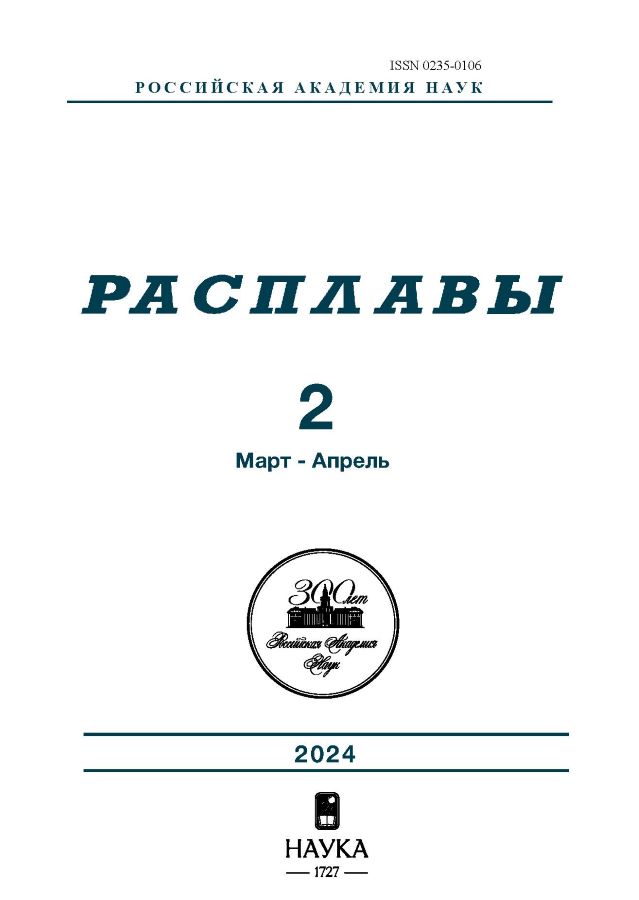Corrosion electrochemical behavior of metal matrix composites “Al-nano-Al2O3” IN 0.5M NaCl aqueous solution
- Autores: Kvashnichev A.1, Yolshina L.1, Pryakhina V.2
-
Afiliações:
- Institute of High-Temperature Electrochemistry Ural Branch of RAS
- Ural Federal University named by B.N. Yeltsin
- Edição: Nº 2 (2024)
- Páginas: 166-178
- Seção: Articles
- URL: https://journals.rcsi.science/0235-0106/article/view/259463
- DOI: https://doi.org/10.31857/S0235010624020029
- ID: 259463
Citar
Resumo
The corrosion-electrochemical behavior of nanocomposites of the “aluminum-nano-aluminum oxide” system, formed by direct chemical interaction of molten aluminum with titanium nanooxide in an environment of molten alkali metal chlorides at temperatures above 700оC, has been studied. Nanoalumina crystals in the α-Al2O3 modification, uniformly distributed throughout the volume of the metal matrix, were detected by means of electron microscopy and X-ray diffraction. The corrosion rate in 0.5M NaCl, determined by the gravimetric method, decreases by 3–4 times when moving from initial aluminum to Al-Al2O3 composites, while the nature of corrosion changes from pitting to uniform and the corrosion resistance class from 3 (resistant) to 2 (very persistent). This is due to the formation of a denser single-phase hydroxide coating on the surface of the composite compared to a two-phase loose coating on aluminum. The corrosion potential is not affected by the incorporation of aluminum oxide nanoparticles into the aluminum matrix.
Texto integral
Sobre autores
A. Kvashnichev
Institute of High-Temperature Electrochemistry Ural Branch of RAS
Email: yolshina@ihte.ru
Rússia, Yekaterinburg
L. Yolshina
Institute of High-Temperature Electrochemistry Ural Branch of RAS
Autor responsável pela correspondência
Email: yolshina@ihte.ru
Rússia, Yekaterinburg
V. Pryakhina
Ural Federal University named by B.N. Yeltsin
Email: yolshina@ihte.ru
Rússia, Yekaterinburg
Bibliografia
- B.F. Schultz, J.B. Ferguson, P.K. Rohatgi. Microstructure and hardness of Al2O3 nanoparticle reinforced Al-Mg composites fabricated by reactive wetting and stir mixing. // Materials Science and Engineering A. 2011. 530. Р. 87–97.
- H. Su, W. Gao, Zh. Feng, Zh. Lu. Processing, microstructure and tensile properties of nano-sized Al2O3 particle reinforced aluminum matrix composites // Materials and Design. 2012. 36. P. 590–596.
- L.A. Yolshina, R.V. Muradymov, D.I. Vichuzhanin, E.O. Smirnova, Enhancement of the mechanical properties of aluminum-graphene composites // AIP Conf. Proc. 2016. 1785. № 1. 040093.
- O.A. Chikova, A.B. Finkelstein, A. Schaefer, Microstructures, mechanical properties ingot AlSi7Fe1 after blowing oxygen through melt // Acta Metallurgica Slovaca. 2017. В23. № 1. P. 4–11.
- P. Ma, Y. Jia, P. Konda Gokuldoss, Zh. Yu, Sh. Yang, J. Zhao, Ch. Li. Effect of Al2O3 nanoparticles as reinforcement on the tensile behavior of Al-12Si composites // Metals. 2017. 359. № 7. Р. 11.
- S. Khireche, D. Boughrara, A. Kadri, L. Hamadou, N. Benbrahim. Corrosion mechanism of Al, Al–Zn and Al–Zn–Sn alloys in 3 wt% NaCl solution // Corrosion Science. 2014. 87. P. 504–516.
- D.K. Koli, G. Agnihotri, R. Purohit. A review on properties, behaviour and processing methods for Al-nano Al2O3 composites // Procedia Materials Science. 2014. 6. P. 567–589.
- B. Wang, L. Zhang, Y. Su, X. Mou, Y. Xiao, J. Liu. Investigation on the corrosion behavior of aluminum alloys 3A21 and 7A09 in chloride aqueous solution // Materials and Design.2013. 50. P. 15–21.
- J. Ma, J. Wen, J. Gao, Q. Li. Performance of Al-0.5 Mg-0.02 Ga-0.1 Sn-0.5 Mn as anode for Al-air battery in NaCl solutions // Journal of Power Sources. 2014. 253. P. 419–423.
- L.A. Yolshina, A.G. Kvashinchev. Chemical interaction of liquid aluminum with metal oxides in molten salts // Materials and Design. 2016. 105. P. 124–132.
- L.A. Yolshina, A.G. Kvashnichev, D.I. Vichuzhanin, E.O. Smirnova. mechanical and thermal properties of aluminum matrix composites reinforced by in situ Al2O3 nanoparticles fabricated via direct chemical reaction in molten salts // Appl. Sci. 2022. 12. № 17. Р. 8907.
- L.A. Elshina, A.G. Kvashnichev, D.V. Pelegov. Electrochemical synthesis of titanium oxide nanopowders in a molten mixture of alkali chlorides and nitrates // Russian Metallurgy. 2021. № 8. P. 1029–1035.
Arquivos suplementares

















